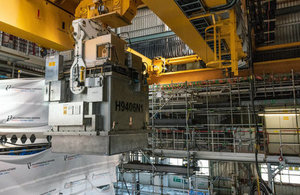A step forward for Sellafield’s most hazardous building
Work to empty the Magnox Swarf Storage Silo has taken a significant step forward.

The 50-tonne package was safely placed onto a machine that will grab waste out of the building
A waste transfer package has been lifted into the building for the first time.
The 50-tonne package was safely placed onto one of three machines that will begin grabbing waste out of the building’s 22 silo compartments from next year.
Originally constructed as six silos in the 1960’s and then extended three times, MSSS stores magnesium cladding or ‘swarf’ that was stripped from Magnox fuel prior to reprocessing.
The swarf is stored underwater in the 16 metre-deep silos but over time the magnesium releases heat and hydrogen meaning the facility requires constant management and monitoring.
Since the early 1990’s this type of waste has been immobilised in concrete instead as this makes it more passive and practical to manage.
The radioactive inventory and lack of modern standards in the silo makes it the most complicated and highest-priority mission in the Nuclear Decommissioning Authority’s estate.
Preparations for removing the 11,000m3 of historic waste from the silos and placing them into safe, modern storage have been over twenty years in the making.
Next year three 360 tonne Silo Emptying Plant (SEP) machines will start reaching in to the silos and removing the waste with a hydraulic grab.
The waste will then be loaded into the shielded transfer packages and safely stored on the Sellafield site until a permanent geological disposal facility is constructed.
Head of Programme for MSSS, Chris Halliwell, said:
The transfer package is the essential link in the chain to safer storage.
It’s a big moment to see it finally being attached to the SEP machine inside the silo.
Never before have these two bits of machinery met inside the place where they’ll be carrying out our biggest job in hazard reduction.
The first transfer package to enter the silo was manufactured by Workington firm TSP Engineering and is one of nine original packages they have built and modified for Sellafield Ltd.
TSP is currently competing with Cavendish Nuclear to build the next batch of 15 transfer packages; an advanced manufacturing contract worth tens of millions of pounds to British Industry.